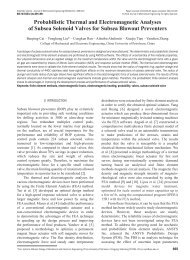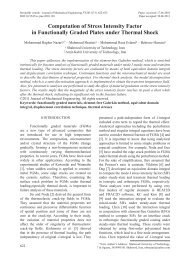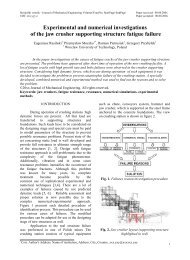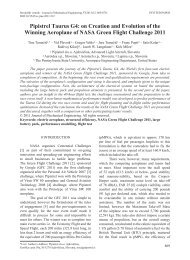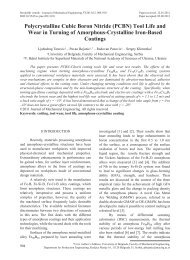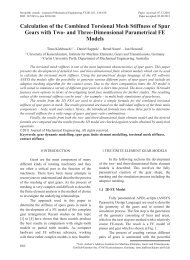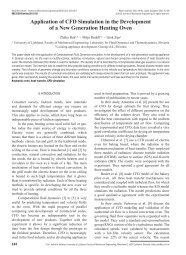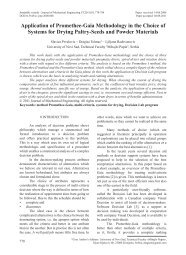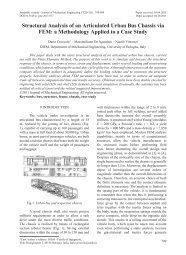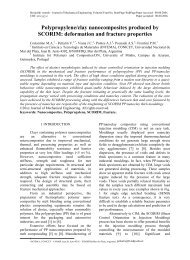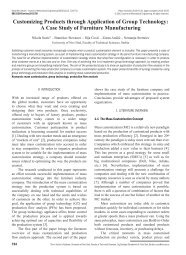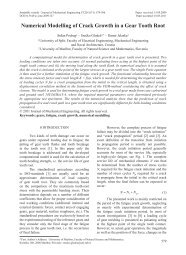Simulation of Water-Gas Shift Membrane Reactor for Integrated ...
Simulation of Water-Gas Shift Membrane Reactor for Integrated ...
Simulation of Water-Gas Shift Membrane Reactor for Integrated ...
- No tags were found...
You also want an ePaper? Increase the reach of your titles
YUMPU automatically turns print PDFs into web optimized ePapers that Google loves.
Strojniški vestnik - Journal <strong>of</strong> Mechanical Engineering 57(2011)12, 911-926wcompPcomp= , (39)n where P comp is the joint power demand <strong>of</strong> all stagesand n P the molar flow <strong>of</strong> the permeate stream. Thecalculated data are presented in Table 6.Table 6. Comparison <strong>of</strong> specific work <strong>for</strong>compression <strong>of</strong> H 2 to 26 barp [bar] 1 2 3P comp [MW] 68.497 51.127 45.475n P [mol/s] 5415.2 5222.2 5075.6w comp [kJ/mol] 12.65 9.79 8.96The calculated data show that specificpower demand <strong>for</strong> the base case (1 bar) isrelatively high compared to other two cases. Incases <strong>of</strong> 2 and 3 bar the power demand is notthat different; there<strong>for</strong>e, operating at 2 bar wouldbe an inviting option. In the future, it wouldbe reasonable to study the trade-<strong>of</strong>f betweenthe higher H 2 production and the lower powerconsumption <strong>for</strong> compression.P4 CONCLUSIONSThe WGSR kinetics was described withBrad<strong>for</strong>d mechanism [4] together with thekinetic data obtained from Graven and Long’s [9]experimental results. The calculations per<strong>for</strong>medin Mathematica were used to calculate the COconversion and the H 2 flux through the membrane.The calculated data were then imported in AspenPlus as input (or initial) values <strong>for</strong> simulations.The model in Aspen Plus was designed as ablack box model, simulating the processes basedon the initial and boundary conditions and thecalculations obtained from Mathematica. Theresults, derived from both models, are in goodagreement with each other and support thecorrectness <strong>of</strong> the designed model.Based on the operational conditions <strong>of</strong>the designed reactor the membrane materialbased on Pd was selected. The calculations showthat the membrane material with permeancek′ = 3·10 -4 mol m -2 s -1 Pa -0.5 . would be sufficient<strong>for</strong> the CO conversion because the process wouldbe reaction and not permeation limited. The COconversion could be enhanced by increasing thereaction rate with the use <strong>of</strong> high temperaturecatalyst or with higher process temperatures.Other studies emphasized that Pd also has somecatalytic properties <strong>for</strong> the WGSR but this wasnot included in the designed model. However, inthe future it would be reasonable to determine thecatalytic properties <strong>of</strong> Pd to accurately predict theWGSR rate, as well. It was established that oneorder smaller membrane permeance would reducethe CO conversion to 50% because the processwould be permeation limited.Based on the selected boundary conditionsthe designed model predicts that 89.1% COconversion can be achieved. With length increase<strong>of</strong> 75% and H 2 molar fraction <strong>of</strong> x H2 = 0.45 in thepermeate stream 92.3% conversion was achieved.But from economic point <strong>of</strong> view the gain in COconversion would not justify the investment cost<strong>for</strong> such a big reactor.Changing the absolute pressure on thepermeate side shows that the trade-<strong>of</strong>f betweenthe CO conversion and the power demand <strong>for</strong>compression <strong>of</strong> H 2 /N 2 gas stream needs to beapproached by further research. The specificpower demand shows that it would be reasonableto set the absolute pressure to 2 bar.The retentate stream is fed to the catalyticburner, where the unconverted CO, unpermeatedH 2 and H 2 S are burned to produce additional heat.Afterwards, the stream contains the SO 2 which canbe removed with conventional FGD technologies.Another possibility <strong>for</strong> the MR in the future maybe the thermal decomposition <strong>of</strong> H 2 S. However,in order to incorporate the process into the MR, itneeds to be studied further.In general, the study shows that theWGSMR is feasible, but there are still manyissues that need to be addressed. First <strong>of</strong> all, themembrane material must retain its structuralstability and permeability during the operatingconditions that are stated. If the material cannotwithstand the acid environment, pre-cleaning <strong>of</strong>syngas would be needed. Proper cooling <strong>of</strong> thereactor also needs to be designed to avoid hotspotsand to keep the reactor operating at isothermalconditions. By introducing cooling tubes intothe reactor, the CO conversion may suffer minorpenalties because less reaction volume will beavailable <strong>for</strong> the WGSR to take place.924 Lotrič, A. ‒ Sekavčnik, M. ‒ Kunze, C. ‒ Splieth<strong>of</strong>f, H.



